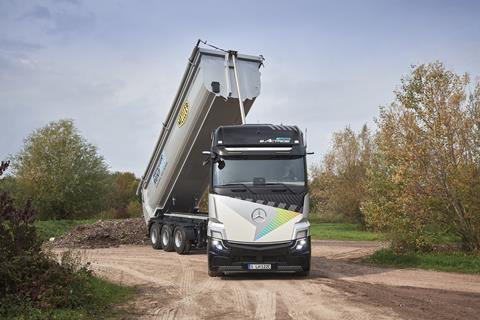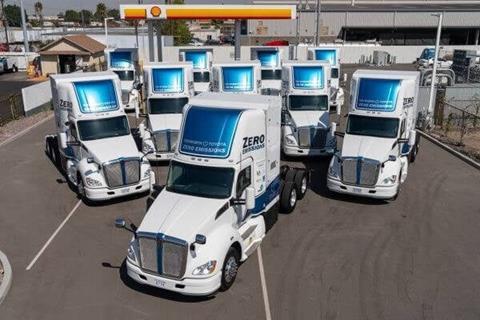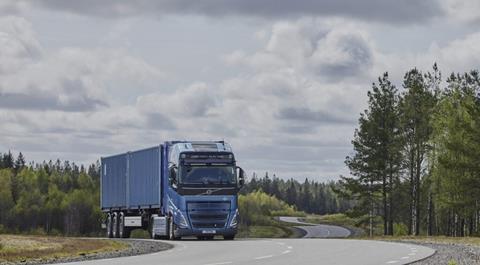Many buyers of tractor units may be just one or two major purchasing decisions away from a switch to emissions-free driving. The technology for heavy-duty transport may not be in situ just yet, but the clock is ticking and green drivetrains are finding homes in other parts of the market. Will North reports.
In just a few years’ time, the question of whether to buy a diesel-powered tractor unit will not be an issue. In 2020, the truck manufacturers that make up the European Automobile Manufacturers’ Association (ACEA, from l’Association des Constructeurs Européens d’Automobiles), pledged to end all sales of diesel engines by 2040, in a statement saying: “The commercial vehicle industry is committed to decarbonisation by 2050 at the latest. This implies that by 2040, all new commercial vehicles sold must be fossil free.”
In 18 years, the members - DAF, Daimler Trucks, Iveco, MAN, Scania, and Volvo Trucks will not offer the option of a diesel engine.
Other deadlines are more pressing. Last year, as part of the COP26 conference in Glasgow, 30 governments pledged to “[move towards] all sales of new cars and vans being zero emission by 2040 or earlier, or by no later than 2035 in leading markets.” They were joined by six carmakers, including Ford, GM, Jaguar Land Rover and Volvo.
Government pledges
But many fleet owners will make their last diesel purchase earlier than those deadlines. Alongside the automotive companies and governments, the pledge was signed by many owners of large car and commercial van fleets, including ABB, GlaxoSmithKiline, Siemens and Vattenfall.
Large corporations are committing to the elimination of fossil fuels in their vehicle fleets in part because of greenhouse gas protocols, a set of accounting standards that consider environmental impacts across the supply chain.
These are split into three ‘scopes’. Scope 1 considers emissions from sources owned and controlled directly by the company; Scope 2 covers emissions from the energy supply chain, such as those produced by a gas power plant or a wind farm; and Scope 3 covers all other emissions in the supply chain, both upstream and downstream.
It is Scope 3 that will add to the pressure on logistics and project forwarding companies to switch to emissions-free operations. Many of the industry’s customers are either multinational companies or state backed enterprises. As these organisations seek to show their environmental commitment to customers, regulators and investors, emissions free transport will become a key competitive consideration.
All of these impacts may be considered hard factors influencing purchasing decisions; they are all essentially measurable, with clear impacts on a company’s bottom line. But softer factors will also come into play. While Covid-19 may be in the rear view mirror in many countries, its impacts on driver recruitment and retention remain. Electric power and electronic systems are tightly linked. Will it be easier to recruit drivers to work in a noisy cab with limited air conditioning, controls and safety systems, or one that is quiet, comfortable and fitted with the latest control and safety technology?
This year’s IAA exhibition in Germany saw a wave of launches and orders for electric heavy goods vehicles (HGVs), as well as announcements of new approaches to vehicle power. In 2024, many visitors to Hannover may be considering which electric vehicles to trial in their fleet; in 2026, they may be deciding on the exact split of electric and diesel vehicles they need; in 2028, with manufacturers firmly on the road to emissions-free transport, and the likely second-hand value of diesel vehicles close to collapse, will anyone be buying diesel?
Light and local

So far, we have looked at the positive factors that are helping pull the sector towards an emission-free future. But there are still obstacles on the road. The most important of these is a lack of suitable energy supply.
In a 2020 pledge, produced in collaboration with the Potsdam Institute for Climate Impact Research (PIK), the ACEA members said: “Those who operate trucks will not invest in zero-emission technologies if there is no straightforward and affordable way to run, refuel and recharge them.
“A successful market deployment of zero-emission trucks will only be possible if a dense network of appropriate infrastructure is rolled out rapidly. This is not a chicken or egg issue: the infrastructure must be available now, as transport companies need certainty that they can fulfil their transport missions.”
While national governments have been slow to meet these needs, individual cities have often been able to for some vehicles. The best examples of this are urban bus networks. These are often owned, or at least regulated, by local governments. Vehicles operate from fixed locations, making scheduled journeys on planned routes at known speeds. This makes it easier to ensure they have access to charging stations, and time to charge.
Sales forecast
In 2021, a report from Dutch bank ING predicted that electric bus sales would reach 4,000 a year in Europe, up from a forecast 2,450 in 2021, and continue to take an ever- expanding share of the market. The bank expects that these will largely be battery powered, saying that the technology is more efficient than alternatives like hydrogen fuel cells.
Amazon was one of the clear beneficiaries of pandemic-induced lockdowns. The online retailer already had a dominant position in Western consumer markets, and the last few years have only propelled it forward. The decisions it makes will help shape global transport for generations.
In October, Volvo signed a deal with the online retail giant to supply 20 of its FH Electric trucks. The company had started accepting orders for its heavy electric trucks in May, including FH, FM and FMX models. Prior to the official sales start, the company had received letters of intent for more than 1,100 heavy electric trucks from more than 20 companies. Serial production of these models began in September. Trucks like this, in the 44-tonne gross combined vehicle weight (GCVW) class, make up around two-thirds of Volvo’s sales.

For operators of international supply chains, like Amazon, the availability of electric trucks in this class is vital. “Amazon is committed to decarbonising its fleet and the middle mile has been a notoriously hard-to-abate sector,” said Andreas Marschner, vice president transportation services, Europe, at Amazon. “That is why welcoming these electric heavy goods vehicles from Volvo into our fleet is such a critical milestone.”
In Poland, Raben Group, which operates two Ikea factories 14 km apart in Zbąszynek and Babimost in the west of the country, will trial Volvo FM Electric trucks for internal transport between plants, using a renewable powered charging point at one of the facilities. Ikea is aiming to reduce greenhouse gas emissions in its transport supply chain, other than last mile distribution to customers, by 70 percent from 2017 levels; the results from the trial, where the tractor units will be pulling 24- tonne trailers, will be used to shape the companies’ broader approach to electrification.
DAF launched its first fully electric truck, the CF Electric, in 2018. The truck boasted a distance between charges of 200 km. With careful planning of charging points and schedules, DAF says, this could allow for 500 km of travel each day, making it suitable for regional supermarket supplies and waste collection routes.
The manufacturer’s latest model, the LF Electric, is designed for local routes. It is a rigid body truck, with a payload capacity of 11.7 tonnes. The first units have been sold to Nabuurs, a food and beverage logistics and distribution company, to supply customers of brewer AB InBev around the Groningen area in the Netherlands.
Dual charging system
The truck uses a dual charging system. With a more expensive 650Vdc, 150 kW charger, it charges from 20 to 80 percent in around 60 minutes, or from empty to 80 percent in two hours. When fast charging is not required, it can go from 20 to 80 percent in six hours, using a more common 400Vac, 22 kW, three-phase charger.
While the truck itself may not be suitable for long-distance project hauls, the combination of charging solutions may suggest methods that could be used to allow for carefully planned long trips: the truck’s 260 kW motor and 282 kWh rechargeable batteries allow for journeys of up to 280 km between charges.
At September’s IAA, Mercedes Benz introduced its eActros Long Haul. It was also on show during October’s bauma exhibition, where it was shown configured with a tipper.

The eActros came into serial production in 2021. The eActros Long Haul has been offered with electric power take-off, or ePTO, on long haul distribution routes. The prototype, Mercedes Benz said, shows how battery-electric power can be used both for transport and for construction tasks.
Mercedes Benz demonstrated the model’s capabilities when a tractor unit version of the eActros pulled a fully loaded 40-tonne semi- trailer on a 111 km journey through the Alps at elevations of up to 1,800 m. The route allowed the company’s test driver and designers to make the most of the vehicle’s regenerative braking systems.
Climbing more than 2,300 m, at grades of up to 13 percent, the tractor was able to recover around 180 kWh of power.
The company has been testing its eActros units extensively across Europe. Distribution versions of the eActros, which are close to serial production, have climbed a total of 54,000 m in Alpine tests.
A key challenge for reliable use of batteries is their narrow range of operating temperatures, which typically require battery modules to be fitted with heating and cooling systems. In one of Europe’s most southerly points, Granada (Spain), eActros units were tested in summer temperatures of over 45 deg C. At the other end of the continent, in the Finnish Arctic city of Rovaniemi, the ‘official home of Santa Claus’, the same range of trucks was able to work in snow and ice at temperatures as low as -25 deg C.
The steel industry is moving towards fossil fuel-free smelting. SSAB recently started production of high-strength steels using hydrogen rather than conventional power sources. This year, Volvo will begin using these steels in the frame rails of some of its tractor units.
For the steel industry to truly achieve net zero, it will have to use electric power in its transport vehicles. Kaunis Iron has a fleet of 90-tonne semi- trailers, which transport ore around the clock on a 160 km road between Kaunisvaara and Pitkäjärvi in northern Sweden.
The company has been testing 74-tonne semi-trailers from Volvo as part of a SEK500 million (USD44.5 million) programme of investment in electrification. Over the winter, it tested a Volvo FMX electric vehicle on public roads, where it worked at temperatures below -30°C.
“Our goal is to achieve fossil- free transport by 2025,” said Lars Wallgren, head of logistics at Kaunis Iron. “We are working hard right now to solve our transport with electric trucks. If we succeed, we can reduce carbon dioxide emissions by about 15,000 tonnes per year at the current production rate. We will start the next phase using 74-tonne trucks in 2023, with the aim of moving up to 90 tonnes. This would be an unchanged gross combination weight compared with today’s diesel-powered crew.”
American electrics
In the USA, truckers have, since the 1970s, taken a similar role in the national imagination as cowboys; their cab back tractor units are as distinctive as a palomino horse. US truck manufacturers are now offering vehicles with clean electric power.
Peterbilt, which like DAF and Kenworth is a subsidiary of PAACAR, offers three electric vehicles, the 220EV, a rigid-body cab-forward truck designed for local deliveries with a range of around 200 miles (320 km); the 520EV, with a focus on refuse collection; and the 579EV, a cab- back tractor targeting the drayage and regional distribution with 150 miles (241 km) of travel possible between charges.

The 579EV has a GCWR of arounds 38 tonnes and is powered by 400 kWh lithium ion batteries, with a three-stage regenerative braking system. It charges in three hours and has a continuous power rating of 536 hp, with peak power of 670 hp.
The company started accepting orders for the 579EV in 2020, with deliveries starting in 2021. This summer, the company delivered two Model 579EVs to Quantix for drayage operation in its Charleston (South Carolina) and Savannah (Georgia) facilities. Quantix specialises in supporting the supply chain of the chemical industry, with more than 50 terminals, warehouses and other facilities across the USA. The new investment, one of the first of the 579EV, is part of a programme to transform its fleet of 3,000 trucks and trailers.
PACCAR’s other US marque, Kenworth, offers its own battery electric tractor unit, the T680E, with nearly identical characteristics. The brand is based in King County, Washington; one of the first units of the tractor was recently handed over to the local waste management authority, which will use it to transfer refuse from the county’s recycling and transfer station in Enumclaw to the Cedar Hills regional landfill in Maple Valley, around 20 miles (32 km) away.
Hydrogen economy
For local deliveries, port handling, and other relatively short-haul operations of a few hundred kilometres between charges, battery electric is now a proven solution. Heavy tractor units suitable for these operations are now in serial production around the world and are available to order. But what of truly long-haul cargo moves?
By carefully placing fast charging stations along regular routes, or by working with charging companies to have these offered at motorway services, project cargo companies may well be able complete many journeys with these same vehicles.
Another approach would be to use hydrogen fuel cells instead of batteries. Kenworth and Volvo have both begun trials of fuel cell vehicles, which promise both longer distances between charges and faster charging.
In September, Kenworth and Toyota completed a trial of 10 fuel cell tractor units, the T680 FCEV. The companies had begun work on these prototypes in 2019, with Kenworth designing the trucks and Toyota supplying the hydrogen fuel cell power system. The trial, conducted around the port of Los Angeles, the Los Angeles basin, and the Inland Empire metropolitan area, focused on comparing the performance of fuel cell trucks to diesel units, with fast charging a key element. It was conducted in partnership with the port of Los Angeles and Shell, which provided the hydrogen fuel infrastructure, and supported by a USD41 million grant from the California Air Resource Board. The 10 trucks for the project were operated by customers including Toyota Logistics Services, Total Transportation Services and Southern Counties Express.
Trial success
The trial compared the performance of Toyota- Kenworth T680 FCEV truck with that of a 2017 diesel engine operating about 200 miles a day. The T680 FCEV has a range of about 300 miles (480 km) when fully loaded to 82,000 lbs (37.2 tonnes). The trial showed that the trucks could be operated continuously, with no downtime between shifts, and charging times of around 15-20 minutes.

Toyota plans to commence production of fuel cell electric powertrain modules at its Kentucky plant next. Kenworth said that the results of the trial will open the door to the use of the technology commercially on other heavy-duty, long-distance routes.
Volvo this summer started its own fuel cell trials. The focus here was on long distances between charges, as well as fast charging. The company says it is targeting operational ranges of up to 1,000 km and charging times of 15 minutes. They will be powered by fuel cells developed by Cellcentric, a joint venture of Volvo and Daimler.
For now, trials have been conducted on the test truck, but Volvo expects to begin customer testing in Northern Europe in 2025.
“The tests will run in a demanding, harsh climate and it also gives us a great opportunity for driving with heavy loads up to 65 tonnes,“ said Jessica Sandström, senior vice president global product management at Volvo Trucks.
This article was first published in the November/December 2022 edition of Freight Carbon Zero’s sister title Heavy Lift & Project Forwarding International (HLPFI).
Supporting documents
Click link to download and view these filesOIP (2)
Other, FileSizeText 17.42 kb














